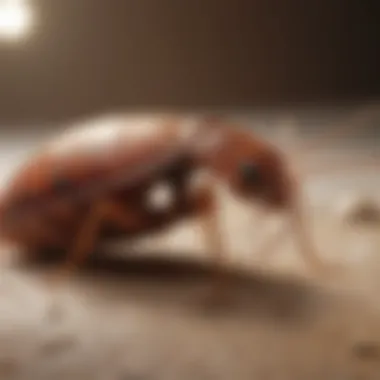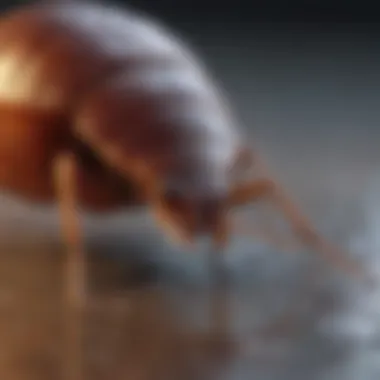Effective Products to Eliminate Bed Bugs for Good


Intro
Bed bugs, scientifically known as Cimex lectularius, are tiny parasitic insects that feed on the blood of humans and animals. Their resurgence in recent decades has sparked concern among homeowners, tenants, and pest control professionals alike. With the rise of travel and changing housing patterns, these bugs have become a prevalent nuisance, invading homes, hotels, and other accommodations.
Effectively addressing bed bug infestations requires a multifaceted approach. In this article, we will explore a range of products available for eradicating these pests, assessing their effectiveness, potential safety hazards, and user-friendliness. Additionally, we will offer practical application techniques to ensure successful implementation.
By understanding both chemical and natural options, readers can make informed decisions about which methods are best suited to their unique situations. The overall goal is to equip individuals with the necessary knowledge to tackle and eliminate unwanted bed bug populations efficiently.
Animal Profile
General Overview
Bed bugs are small, flat, and oval-shaped insects that typically measure around 5 to 7 mm in length. Their reddish-brown color and belonging to the Cimicidae family makes them easily identifiable. They do not have wings, yet they are remarkably adept at hiding in tiny crevices, making detection challenging.
Habitat and Distribution
Bed bugs thrive in a variety of environments. They are commonly found in homes, particularly in bedrooms where they can easily access their food source - human blood. Bed bugs have adapted to live in various climates, resulting in their worldwide distribution. They are often found in urban settings where dense populations of residents facilitate easy travel between locations, further spreading infestations.
Effective Products for Elimination
Chemical Insecticides
Chemical insecticides are among the most commonly used products for eliminating bed bugs. These chemicals, such as pyrethroids, act upon the nervous system of bed bugs, leading to their demise. Popular commercial brands include Raid Bed Bug Killer and Hot Shot Bed Bug and Flea Killer. It is crucial for users to follow the instructions strictly and consider safety measures, particularly in homes with pets or small children.
Natural Alternatives
For those who prefer to avoid chemicals, natural alternatives exist. Products containing diatomaceous earth or essential oils like lavender or tea tree can be effective. These options may not yield immediate results but can help in controlling populations over time. Some notable brands are EcoSMART Organic Bed Bug Killer and Bed Bug Patrol.
Prolusion to Bed Bugs
Bed bugs (Cimex lectularius) are small, parasitic insects that feed on the blood of humans and animals. Their resurgence in recent years has sparked significant concern among homeowners, renters, and travelers alike. Understanding bed bugs is paramount for effective control and elimination strategies. Awareness can prevent infestations from growing, as these pests are adept at hiding and reproducing rapidly.
The importance of knowing about bed bugs extends beyond merely recognizing their presence. It includes understanding their behavior, their lifecycle, and the signs of an infestation. Each of these factors plays a critical role in the efforts to eliminate them. This article delves into multiple approaches for bed bug eradication, offering insights on both chemical and natural solutions.
Understanding Bed Bug Behavior
Bed bugs primarily hide during the day and become active at night. They prefer to dwell in warm, secluded places, often clustering around sleeping areas. Their behavior makes them particularly difficult to detect until an infestation has progressed. Bed bugs can travel quickly and hitch rides on clothing, luggage, and furniture. They can reproduce at notable speed—females can lay hundreds of eggs in their lifetime,
To effectively eliminate them, one must first understand their typical hiding places. Common areas include:
- Mattresses and box springs
- Bed frames and headboards
- Baseboards and wall cracks
- Electrical outlets and appliances
Notably, the adaptability of bed bugs contributes to their persistence. They can survive for months without feeding, which complicates eradication efforts. It is essential to develop a comprehensive strategy that considers their behavior and habits.
Signs of Bed Bug Infestation
Detecting bed bugs early is vital to mitigate a larger problem. Many signs indicate a potential infestation:
- Bites: Small, itchy welts on the skin, often in a line or cluster.
- Fecal spots: Dark, small stains on sheets, mattresses, or furniture indicate droppings.
- Egg casings: Tiny, white shells left behind after eggs hatch, commonly found near bedding areas.
- Unpleasant odor: A musty smell can linger if there's a large population.
Being aware of these signs can lead to quicker action, reducing the overall impact of an infestation. Proactive monitoring is critical; regular inspections of sleeping areas can help identify bed bugs early on.


Chemical Products for Bed Bug Control
Chemical products play a crucial role in the management of bed bug infestations. Their targeted action effectively reduces populations and helps restore a pest-free environment. Understanding these products and their mechanisms can influence treatment success. Utilizing chemical options judiciously can mean the difference between a brief intervention and a prolonged struggle. Here, we will explore different types of chemical products, their benefits, and key considerations.
Insecticide Sprays
Insecticide sprays are a popular choice for immediate bed bug control. These products are usually ready-to-use and can be applied directly to infested areas. Many contain active ingredients like pyrethroids or neonicotinoids, designed to quickly knock down bed bugs.
- Advantages: Insecticide sprays offer quick action and penetrative capabilities, allowing them to reach areas where bed bugs hide, such as seams and cracks. Their versatility enables application on various surfaces, making them ideal for homes and hotels.
- Considerations: While effective, relying solely on sprays can lead to resistance in bed bug populations. Rotating different types and brands can obviate this issue. Additionally, sensitivity to chemicals may necessitate caution when using these products in households with pets or small children.
Powders and Granules
Powders and granules remain effective tools in bed bug management, primarily for their residual properties. After application, these products stay effective for weeks or even months, providing ongoing protection as bed bugs encounter treated areas.
- Benefits: Powders like diatomaceous earth act as desiccants, removing moisture from the insects and leading to their eventual death. They can be applied in crevices or under furniture surfaces, where traditional sprays cannot reach.
- Drawbacks: Despite their advantages, powders require careful application to avoid disrupting their efficacy. Moreover, they might cause respiratory irritation if inhaled, making suitable protective gear essential during use.
Foggers and Aerosols
Foggers and aerosols represent a powerful option for treating large areas infested with bed bugs. They disperse insecticides in a fine mist, allowing for coverage of hard-to-reach locations. This method can be especially useful in larger infestations or multi-room scenarios.
- Effectiveness: Foggers can penetrate deeper into furniture, wall spaces, and carpets, addressing hidden pests that may elude other treatments. They are ideal for a broader application where a systemic approach is needed.
- Limitations: However, complete evacuation of treated areas is essential. Safety concerns arise regarding exposure to toxic residues; hence, following manufacturer guidelines becomes imperative. Furthermore, the formulation of foggers can vary, and some may not specifically target bed bugs, requiring careful selection.
Understanding how each type of chemical product works can significantly enhance your pest control strategy. Selecting methods suited to specific situations creates a more efficient approach.
Natural Remedies for Bed Bugs
Natural remedies for bed bugs are gaining attention due to their potential effectiveness and safety. As more people seek alternatives to chemical treatments, understanding these remedies is vital. They may provide a solution for those who prefer environmentally friendly options or want to reduce exposure to synthetic chemicals.
Natural products often have fewer side effects, making them a desirable choice. However, it is essential to recognize that they may not always work as quickly or effectively as chemical options. Another consideration is that while these remedies can assist in control, combining them with other methods may improve results.
Diatomaceous Earth
Diatomaceous earth is a natural powder made from fossilized algae. It is widely recognized for its unique ability to dehydrate bed bugs. When these pests come into contact with the powder, it damages their exoskeleton, leading to dehydration and eventual death.
Using diatomaceous earth is straightforward. It is sufficient to spread a thin layer in areas prone to bed bugs, such as beneath bed frames, along baseboards, and in cracks and crevices. However, it is crucial to ensure the powder is food grade to guarantee safety.
- Results can take several days to become evident.
- Daily applications may be necessary until the infestation is under control.
- Avoid inhaling the dust, as it can irritate the lungs.
Essential Oils
Essential oils, such as lavender, tea tree, and peppermint, are also popular natural remedies. Their strong scents can repel bed bugs, and some oils have insecticidal properties. While they may not eliminate infestations outright, they can deter bed bugs from settling in treated areas.
To use essential oils effectively:
- Mix a few drops of the desired essential oil with water in a spray bottle.
- Spray the solution around infested areas and on bedding.
- Reapply frequently, especially after cleaning or washing bedding.
Keep in mind that results can vary, and essential oils may not provide a complete solution.
Heat Treatment Methods
Heat treatment is another effective natural remedy. Bed bugs are vulnerable to high temperatures. Washing infested items in hot water and drying them on a high-heat cycle can kill both bed bugs and their eggs.


For larger items, such as mattresses or furniture, professional heat treatment services are available. These methods involve using specialized equipment to raise the temperature in a room, effectively exterminating bed bugs.
- It generally requires temperatures of at least 120°F (49°C).
- Ensure that other heat-sensitive items are removed prior to treatment.
- Follow-up treatments are recommended to address any remaining bugs or eggs.
Natural remedies for bed bugs can provide some level of control, but understanding their limitations is crucial for effective pest management. Combining natural and chemical methods may yield the best results.
Natural remedies offer alternative options for those facing bed bug challenges. While these solutions may not completely eradicate infestations, they can complement other strategies and help build a comprehensive pest management plan.
Mechanical Approaches to Bed Bug Removal
Mechanical methods are crucial in combating bed bug infestations. Unlike chemical treatments, these approaches can be immediate and effective in reducing bed bugs without the need for potentially harmful substances. Additionally, they can be used in conjunction with chemical and natural methods for a comprehensive pest management strategy. In this section, we will explore various mechanical approaches, detailing the benefits and considerations for each.
Vacuuming Techniques
Vacuuming is one of the first lines of defense against bed bugs. It offers a straightforward method to quickly remove insects and eggs from infested surfaces. Using a vacuum cleaner designed for pest control is advisable. A powerful vacuum equipped with a HEPA filter can capture the small particles that contain bed bugs.
Best Practices for Vacuuming:
- Target Areas: Focus on seams of mattresses, bed frames, and baseboards where bed bugs are commonly found.
- Attachments: Utilize specialized attachments like crevice tools. These can reach tight spots.
- Frequent Disposal: Empty the vacuum bag or canister frequently. Seal it tightly before discarding to prevent escape.
- Follow-Up: Vacuuming alone might not eliminate bed bugs completely. It's often beneficial to continue vacuuming for several days after initial treatment.
Steam Cleaning
Steam cleaning is effective with high temperatures that kill bed bugs and their eggs on contact. This method eliminates the need for chemicals, making it favorable for environments like homes with children or pets. The steam should be above 200°F for optimal effectiveness.
Key Considerations:
- Equipment: Use a commercial-grade steam cleaner. Ensure it has the capacity to produce continuous steam.
- Application: Move slowly and deliberately over areas where bed bugs are suspected. This allows the steam to penetrate fabric and surfaces properly.
- Drying Time: After treatment, allow areas to dry completely as humidity can lead to mold growth.
Bed Bug Interceptors
Bed bug interceptors act as traps placed under furniture legs. They prevent bed bugs from crawling onto beds or couches. These devices are an important part of prevention and monitoring.
Functionality:
- Design: Interceptors typically have two chambers—one for entry and another for trapping. Once the bugs enter, they cannot escape.
- Placement: Place interceptors under all bed and furniture legs. This creates a barrier against invading bed bugs.
- Regular Check: Inspect them regularly to identify any active infestations. This can help inform further treatments or assist in evaluating ongoing preventative measures.
Regular monitoring using interceptors can not only help in detecting the presence of bed bugs but also offer peace of mind in your pest control strategy.
Utilizing these mechanical approaches forms a critical part of a comprehensive plan to combat bed bugs. Each method has its advantages and should be applied with care to ensure efficacy.
Evaluating Product Safety and Efficacy
Evaluating the safety and efficacy of products designed to combat bed bugs is crucial for effective pest management. When dealing with infestations, one must consider both the immediate results of the product and the potential long-term effects it may have on health and the environment. A thorough understanding of product safety ensures that methods chosen do not adversely impact individuals, pets, or the living space.
This section will explore how to interpret labels and instructions accurately, emphasizing adherence to guidelines to maximize effectiveness. Additionally, identifying trusted brands will help in making informed decisions, ensuring the products used are reliable and proven.
Understanding Labels and Instructions
Deciphering product labels is fundamental in effective pest control. Labels provide essential information regarding usage, safety precautions, and active ingredients. Understanding these elements prevents misuse and enhances overall safety and efficiency.
- Active Ingredients: Identify the chemicals responsible for killing bed bugs. The concentration often determines efficacy.
- Usage Instructions: These include detailed guidance on application methods, necessary amounts, and frequency. Observing these instructions is critical to achieving satisfactory results without unnecessary exposure to chemicals.
- Safety Precautions: Look for statements regarding the safety of the product for children and pets. Understanding risk factors helps in planning appropriate interventions to avoid exposure.
- Storage and Disposal Information: Improper storage can lead to accidental exposure, while incorrect disposal may harm the environment. Knowing how to handle products after use is essential.


It is important that users thoroughly read the labels to optimize product effectiveness and mitigate risks. This process is not optional; it is an essential step to ensure a safe and successful pest control experience.
Identifying Trusted Brands
When choosing products to eliminate bed bugs, the credibility of the brand plays a significant role. Not all products on the market are equal, and some may not yield the results they promise. Trusted brands usually have a history of reliability and customer satisfaction.
Key aspects to consider include:
- Reputation: Research online reviews and ratings to gauge user satisfaction. Websites such as reddit.com and en.wikipedia.org can provide insights and community discussions about specific brands.
- Certifications: Look for products certified by pest control associations. Certifications often indicate adherence to safety standards and quality assurance methodologies.
- Transparency: A trustworthy brand provides clear information not just about what the product does, but also about how it works. Transparency in ingredients and research backing the product is a positive sign.
- Availability of Customer Support: Reliable brands often offer robust customer support. They are ready to assist with questions or concerns about product use.
In summary, careful evaluation of safety and efficacy is a key component in addressing bed bug infestations. By understanding labels and identifying trusted brands, consumers can make informed choices that not only target bed bugs effectively but also safeguard their households.
Integration of Pest Control Strategies
The management of bed bugs involves a multifaceted approach. These pests are resilient and can quickly reproduce, making it imperative to employ a variety of strategies. Integration of pest control strategies combines chemical treatments, natural remedies, and mechanical methods to enhance effectiveness. By understanding each component, one can create a comprehensive plan tailored to specific situations.
Effective integration leads to a higher success rate in eliminating bed bugs. Here are some key benefits of adopting a multi-pronged approach:
- Broader Reach: Using multiple methods ensures that bed bugs in various life stages are targeted.
- Reduced Chemical Resistance: Regularly alternating between different treatments minimizes the risk of bed bugs developing resistance to a particular type of insecticide.
- Comprehensive Inspection: Integrating various methods encourages thorough inspections and continuous monitoring of the infested area.
Considerations for integrating pest control strategies include knowing the specific products being used and their compatibility with others. This helps in avoiding any adverse reactions that could occur from using incompatible methods together.
Establishing an effective combination means paying close attention to the timing and method of application. Familiarity with each product’s label enhances understanding, ensuring that one follows proper usage instructions for optimal safety and efficacy.
Combining Chemical and Natural Methods
A successful strategy can often be found at the crossroads of chemical and natural remedies. Chemical products such as insecticide sprays or powders work quickly and relieve immediate issues. Meanwhile, natural methods like diatomaceous earth and essential oils provide ongoing protection and are safer for the environment.
- Efficacy: Insecticides like Temprid and Bed Bug Killer deliver fast results. However, they should be paired with preventive approaches for lasting impact.
- Safety: Natural remedies are less harsh on home environments, acting as a supplementary measure in substantial eradication plans.
Utilizing both methods can contribute to a more effective defense against bed bugs while also allowing for flexibility depending on the situation at hand. It is important to apply them in consideration of their respective timing and placement. For instance, applying a chemical treatment may require a waiting period before using natural solutions to avoid interactions that could limit effectiveness.
Regular Maintenance and Monitoring
Regular maintenance plays a crucial role in preventing bed bug infestations. Consistent monitoring helps in early detection, which can save significant time and resources. Here are some key aspects:
- Continuous Inspection: Routine checks of bedding, furniture, and hidden areas can catch infestations in their infancy, allowing for quick action.
- Seasonal Treatments: Implementing preventive treatments regularly can lower the risk of future outbreaks, especially in high-risk areas.
- Education: Keeping informed about bed bug behavior and emerging products enhances one's ability to respond effectively when issues arise.
End
The conclusion serves as a crucial summary of our exploration into effective products for eliminating bed bugs. Bed bugs present persistent challenges for households, hotels, and various public spaces. Understanding the strategies detailed in this article empowers individuals to take informed action against these pests.
Recap of Effective Strategies
Addressing bed bug infestations often requires a multifaceted approach. It is essential to integrate different methods to achieve optimal results. A summary of the key strategies includes:
- Chemical Products: These include insecticide sprays, powders, and foggers. Their effectiveness is contingent on proper application and adherence to safety guidelines.
- Natural Remedies: Utilizing diatomaceous earth and essential oils presents non-toxic options for those seeking less harmful solutions.
- Mechanical Methods: Vacuuming and steam cleaning can significantly reduce bed bug populations, while interceptors can help monitor and trap them.
- Integrated Pest Management: Combining various methods provides a comprehensive solution, enhancing overall efficacy. Regular monitoring and maintenance are paramount in preventing re-infestation.
"A diligent and thorough approach not only targets existing bed bugs but also mitigates the risk of future infestations."
Long-term Prevention Tips
When dealing with bed bugs, prevention is as critical as elimination. Some effective long-term strategies include:
- Regular Inspections: Periodically check bedding, furniture, and luggage for signs of bed bugs to catch potential issues early.
- Encasements for Mattresses: Invest in high-quality mattress encasements to reduce the likelihood of bed bugs establishing colonies.
- Laundry Practices: Wash and dry bedding and clothing at high temperatures. Utilize plastic bags to transport items from infested areas.
- Clutter Management: Minimizing clutter can reduce hiding spots for bed bugs, making inspections and treatment easier.
- Professional Extermination: Consider hiring pest control experts for regular assessments and treatments if infestations are recurrent.
By adopting these strategies and remaining vigilant, individuals can enhance their ability to combat bed bugs effectively and prevent future occurrences.















